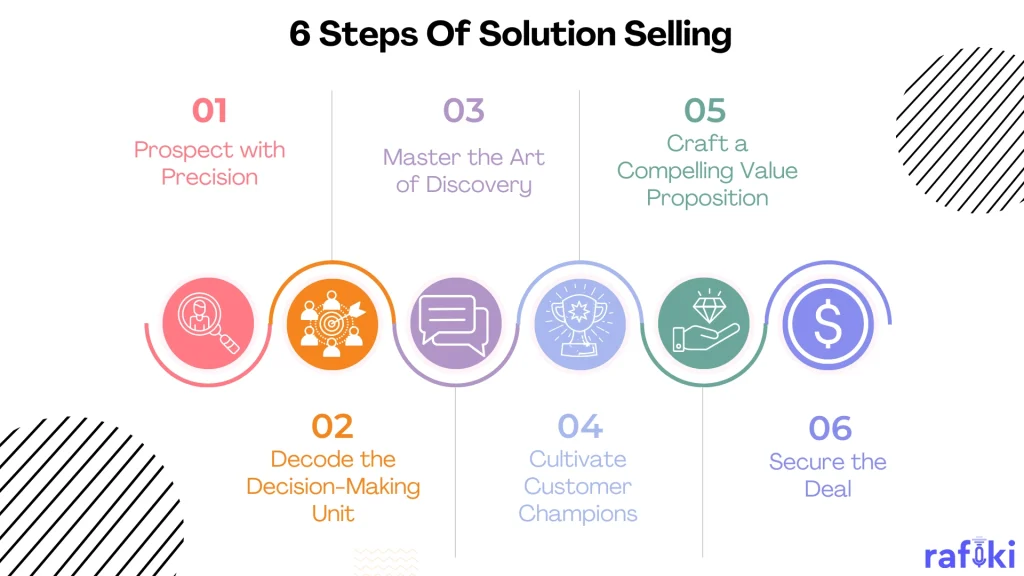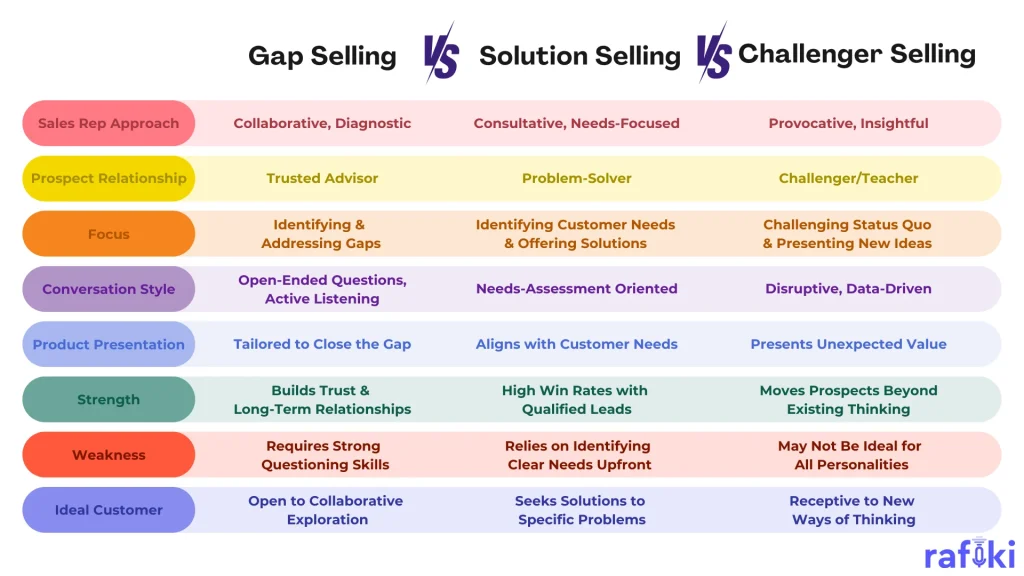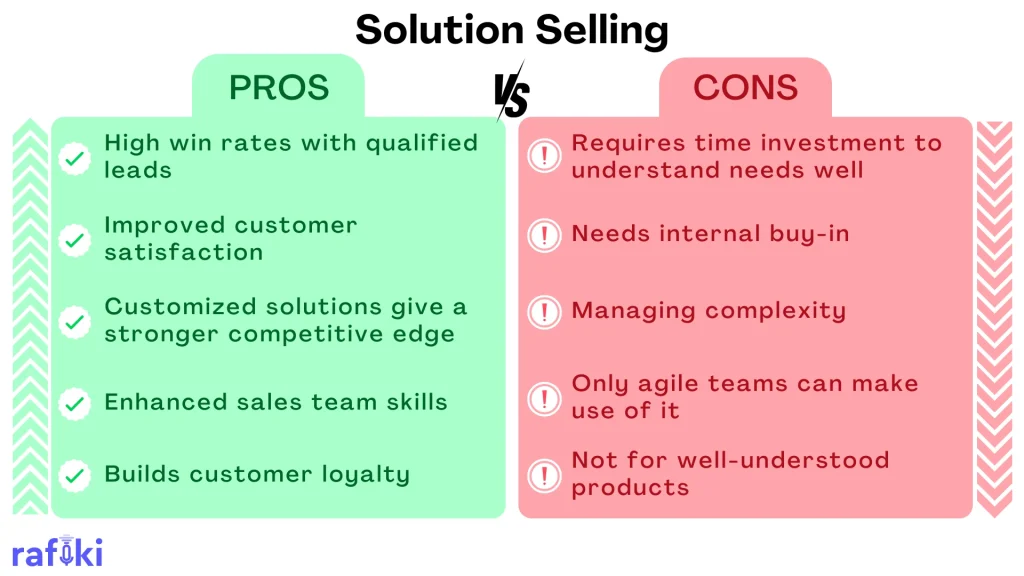Why Rafiki
Pricing


Pricing
Solutions

RevOps Leaders
Synchronize revenue generating functions

SDR Leaders
Get your team aligned and Coach your Reps 3x faster at scale

Sales Leaders
Unlock pipeline truth, drive confident forecasts

Think your customers are tired of the same old "features and benefits" spiel? The truth is, traditional sales tactics are about as effective as using a rotary phone in the age of smartphones. Today's buyers are smarter, their needs are complex, and they expect solutions, not just products. This guide dives into the world of Solution Selling, the secret sauce for building a high-performing sales team that thrives in a customer-centric world.
Get ready to ditch the tired scripts and learn how to truly connect with your customers, solve their problems, and close more deals than ever before.
Let’s get into it!
Okay, ditch the product brochures and dust off your detective hat. Solution Selling is all about understanding your customer's needs and then tailoring your approach to address them. It's a bit like solving a mystery – you gotta ask the right questions, gather clues (customer pain points!), and then present a solution that feels like a revelation, not a sales pitch.
Here's the shift: instead of rattling off features, you're focusing on value. For example, imagine you're selling cybersecurity software. Traditionally, you might talk about encryption protocols and firewalls. With Solution Selling, you'd dig deeper. Ask the customer about recent security breaches or their biggest concerns about data protection. Then, you can explain how your software can prevent those specific issues, saving them time, money, and headaches. See the difference? It's about the specific value your prospects will get by using your solution, not just features.
This approach builds trust and positions you as a problem solver, not just another salesperson. And guess what? Customers are more likely to buy from someone they trust and who genuinely understands their problems.
Transforming your sales team into solution-selling champions requires a strategic approach. Here's a 6-step roadmap to cultivate a powerhouse that consistently delivers value to customers:

Don't waste time on unqualified leads. Train your reps to identify ideal prospects facing challenges your product or service can demonstrably solve. This might involve industry research or leveraging marketing automation tools to target leads who exhibit specific buying behaviors.
Selling is rarely a solo act. Understand who holds sway in the buying decision. Is it the CEO, a department head, or a committee? Map out the DMU and tailor your approach to resonate with each stakeholder's priorities.
This is where the magic happens! Equip your reps with active listening skills and powerful questioning techniques. Instead of launching into a product spiel, ask insightful questions to uncover the buyer's specific needs, pain points, and budget constraints.
For example, instead of simply mentioning features of your customer relationship management (CRM) software, ask a prospect, "What are some of the biggest challenges you face in managing customer interactions?" By truly understanding their situation, your reps can then propose solutions that directly address those challenges.
Identify individuals within the prospect's organization who are enthusiastic about solving the problem you address. These champions can provide valuable insights and advocate for your solution within the DMU.
Go beyond features and benefits. Show the buyer the tangible ROI your solution delivers. This could involve calculating potential cost savings, increased efficiency metrics, or improved customer satisfaction rates. Remember, it's not about what your product does; it's about how it transforms the buyer's business.
Once you've presented a customized solution and demonstrated its value, it's time to close the deal. Negotiate win-win terms and ensure a smooth onboarding process. Remember, Solution Selling is a long-term commitment, so focus on building a lasting partnership with your customer.
By following these steps and equipping your team with the right skills, you'll be well on your way to building a powerhouse that consistently delivers value and drives sales success.
Solution Selling is a powerful tool, but it's not a one-size-fits-all approach. So, when exactly should you unleash this sales superpower?
Here's the golden rule: Solution Selling shines brightest when dealing with complex situations and high-value deals. Think enterprise software deals or scenarios where customers have intricate challenges that require a customized approach. In these cases, simply listing features and benefits won't cut it. Customers need a problem solver who can understand their unique needs and craft a solution that solves their specific problems.
However, Solution Selling might not be the most efficient approach for every interaction. For instance, if you're selling a well-understood product with a clear value proposition, a more traditional sales pitch might suffice. The key is to identify the right sales strategy for the right situation. When in doubt, remember this: Solution Selling thrives on complexity and customization. For simpler situations, a more streamlined approach might be the better course of action.
If Solution Selling is in fact unsuitable for you, explore these other effective sales methodologies such as Gap Selling or Challenger Selling. Here’s a comparison between the three approaches:

The sales landscape is constantly evolving, and Solution Selling needs to adapt to keep pace. Here's how to integrate its principles into the modern sales process for 2024:
Embrace the power of data and technology. Today's customers are more informed than ever. Leverage tools like social listening platforms (Hootsuite, Brandwatch, Brand24 and the like) and marketing automation software to gather intel on customer needs and buying behaviors. This intel can inform your pre-call research and help you tailor your approach from the get-go.
Think beyond the initial sale. Solution Selling isn't just about closing the deal; it's about building long-term customer relationships. Incorporate success metrics that go beyond conversion rates, such as customer satisfaction and retention rates. This will incentivize your team to prioritize solutions that deliver ongoing value for customers.
Get comfortable with agility. Customer needs can shift quickly, and your Solution Selling approach needs to adapt accordingly. Encourage open communication with customers and leverage tools like Rafiki's Smart Follow Up. This feature automatically generates personalized follow-up emails based on call conversations, ensuring your reps can address any evolving needs or concerns promptly. By fostering agility and responsiveness, your team can ensure their solutions continue to resonate with customers throughout the buying journey.
So, you've implemented Solution Selling, your team's rocking customer conversations, and deals are closing. But how do you know if your strategy is truly effective? Well, there are two parts to this, first of which is understanding where Solution Selling shines & fails. Knowing the pros and cons of Solution Selling will help you get the context before doing the actual measurement:

With this context, let’s enter the wonderful world of metrics!
Here are some key performance indicators (KPIs) to track the success of your Solution Selling approach:
Remember, data is your friend! Utilize tools like Rafiki's Smart Call Scoring to gain objective insights into rep performance on calls. This can help identify areas for coaching and ensure your entire team is consistently delivering high-quality Solution Selling conversations.
Don't be afraid to experiment and refine your approach based on your findings. The beauty of Solution Selling is its adaptability. By continuously measuring and analyzing results, you can ensure your sales team is constantly honing their skills and delivering solutions that resonate with your customers.
The future of sales is clear: prioritize connection over closing, and problem-solving over product pitches. Solution Selling empowers you to become a problem solver, not just a salesperson.
Implement & Optimize Solution Selling
By equipping your team with the right skills and leveraging technology like Rafiki, you can build a solution-selling powerhouse that drives sales and customer loyalty. Embrace this shift, explore how Rafiki can help you implement, track and optimize Solution Selling by signing up for a free 14 day trial today!